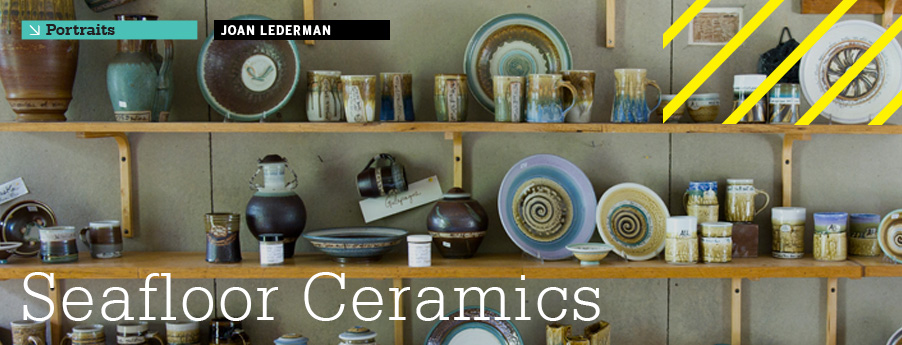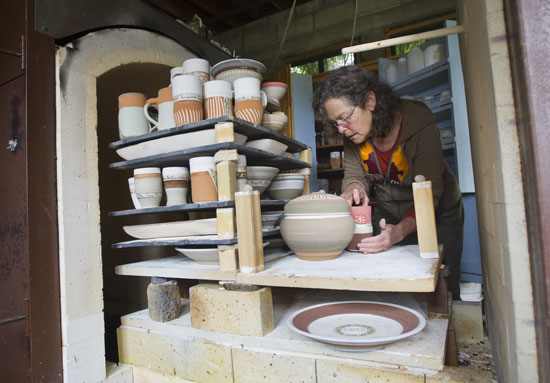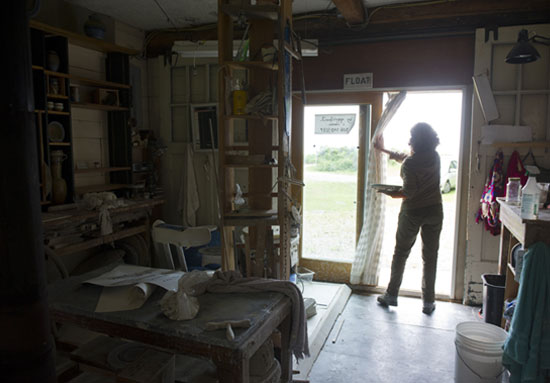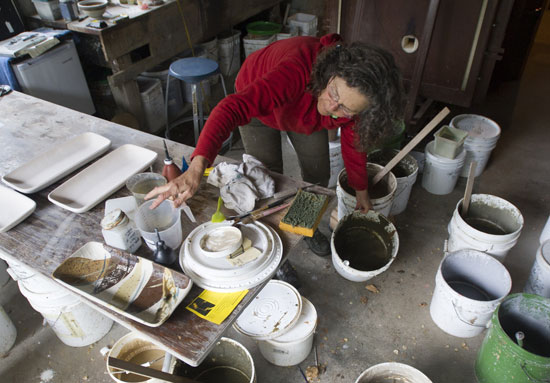Seafloor Ceramics
An artist creates glazes from ocean floor sediment
By Lara Ehrlich | Photography by Cydney Scott
At the end of a long road curving along the sea in the Cape Cod town of Woods Hole, Massachusetts, a handmade sign points the way to the Soft Earth pottery studio. There, in a converted boat shed warmed by a wood stove, Joan Lederman (’68) works at a pottery wheel with a view of the ocean. The walls are lined with stoneware and porcelain, each with a compelling story of its origin. Researchers from the Woods Hole Oceanographic Institution (WHOI) just down the road supply Lederman with the mud she uses to create glazes that crackle or branch into veins or gleam like glass. Research ships return to the institution from journeys around the globe, bearing mud from the largest underwater volcano in the world and sediment from a layer of Earth rich in iridium from the asteroid said to have killed the dinosaurs, among other materials. In the crucible of Lederman’s kiln, mud is transformed into art.
Mud Stories
“My husband died the year before the mud came to me,” she says. It was 1996, her daughter was 12, and she was not looking for a new artistic direction that would further destabilize their lives. But when an acquaintance, a crane operator on a WHOI ship, brought her a bucket of mud, she was intrigued. “My kiln was on, so it was already incandescent hot inside,” she says. She put a sample inside to see what it would do, and it melted into a “little glob,” proving it could be used as a glaze. Lederman knew she was onto something, but she didn’t know much about glazing, a complex process that requires precise measurement and expert manipulation of a kiln’s temperature and air circulation. Miscalculation will destroy a piece—or a kiln-full of work.
“I never studied glazes,” Lederman says. “It’s all just my fooling around.” For the first few years, she lost nearly 70 percent of her work. “I was putting the mud too thick on the outside; it would run on the shelf, it would break—all kinds of reasons. I started to leave my mistakes around so I wouldn’t do the same one twice.”
As she fine-tuned her process, WHOI researchers continued to bring her leftover sediment from their voyages, captivated by the way she transformed the material. “Joan takes the geological aspect of the sediments we collect on the seafloor and weaves them into her work to portray an awareness of Earth,” says Dan Fornari, a senior scientist in the institution’s geology and geophysics department. “This gives richness to her work—and to mine, because it puts people closer to ‘abstract’ science. Using the materials from the deep ocean in her work provides an opportunity to both educate and enthrall people.”
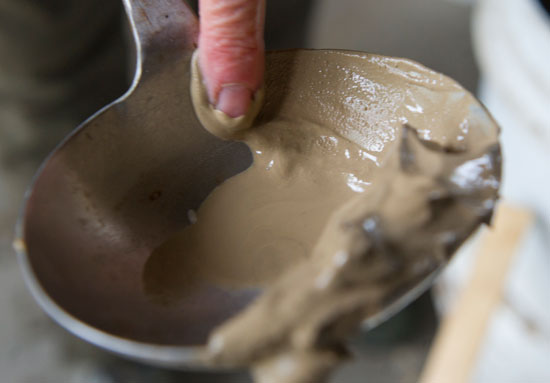
“When I first get a bag of mud, I ask, ‘Now what do I do with you?’” Lederman says. Sediments from around the world respond to firing in different ways depending on their composition. Lederman’s newest mud is from the Havre Volcano, an underwater volcano just north of New Zealand.
The garage that houses Lederman’s kiln is packed with buckets of mud bearing the names of researchers, ships, and geographical coordinates. There is Mouth of Amazon, Phoenician Wreck, Pacific Monitoring of Fukushima Radiation, Red Sea. “Every one is from a ship that went out to sea where people were investigating things and archiving it,” she says. “It’s all about the stories.”
Collecting mud stories has turned Lederman into an amateur geologist. She strides from shelf to shelf in the garage, opening buckets, stirring slurry, rubbing sludge between her fingers. A sediment’s response to firing often mirrors how it was formed by forces deep within the Earth, she says. Magma that bubbled up from a fissure on the planet’s surface “crumbles and melts back into my kiln.” Decomposed volcanic rock “fires like the pounded rock it had been before wind abrasion and water erosion broke it down.” Sediment trapped between two ocean plates and mashed into an oil-like slurry “dries and curls and melts back down into something rock-like.” This is a process “I experience viscerally,” she says. “I feel like my hands are on the pulse of Earth, almost as if I’m touching her blood.”
Lederman scrapes lumpy mud from the side of a bucket. “Can you see the little granular things?” she asks, digging into the sludge with her fingernail. “These are foraminifera, or forams,” single-celled organisms with shells composed of seawater minerals. Researchers study the shells that have collected in seafloor sediment to learn how climate change is impacting the oceans. When exposed to the kiln’s heat, mud that contains forams creates branching patterns in the glaze.
She digs a small jar out of a cabinet and opens it reverently. The mud inside is almost black, and so thick it barely moves when she tips it. This is sediment from the layer in the Earth’s core that dates back 65 million years and is composed of dust from the asteroid that is believed to have led to a mass extinction. When Lederman first tested the sediment, she had no idea what it would do. When applied as a thick glaze, it separated, speckling the ceramic surface “like mud clouds,” she says.
This past summer, Lederman was working with a new material: sediment from the largest underwater volcano in the world, just north of New Zealand. Scientists discovered the Havre Volcano in 2012, when they traced the source of mysterious pumice rafts floating on the ocean. Applied as a thin layer, the volcano sediment reveals the porcelain or stoneware beneath it; when applied thickly, it fires like smoky glass.
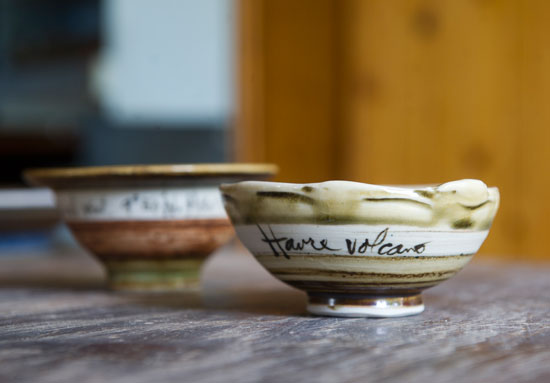
Lederman often inscribes her pieces with the mud’s geographic coordinates. She tags a finished bowl with “Havre Volcano”; the sediment has resulted in a glaze as rich and smoky as the underwater eruption from which it came.
Lederman works from spring to fall, when her studio is warm enough for the clay. She begins with wheelwork to create the stoneware and porcelain forms. When she has about 80 to 100 pieces ready—enough to fill the kiln—she dries the raw pottery at low heat for about 15 hours, then raises the heat to 1,700 degrees for another 6 to 8 hours. She creates glazes by mixing the sediments with water to achieve different consistencies, depending on her vision for each piece. She often writes the sediment’s geographic coordinates in flowing script across a piece. She fires the pottery—now glazed—again at about 2,300 degrees for 10 hours.
During her off-season, Lederman works on her website, catches up on blogging her mud stories, updates her bookkeeping, and takes entrepreneurship courses. “Some people call me an entrepreneur, and other people go, ‘What?’ because the scale is so small,” she says. “A lot of mainstream business people assume if the number isn’t big, then there isn’t a demand, but it’s not that at all.” To Lederman, it’s about “finding the delicate balance of a tightrope walker who has one foot out ready to take the next step in an atmosphere so foggy that the line isn’t visible yet.”
Lederman thrives on uncertainty; her work relies on a precarious manipulation of Earth, air, fire, and water. “I didn’t always like that I would have something in my mind that I wanted, put it in the kiln, and get nothing like it,” she says. “But I soon learned that almost everything I didn’t get was counterbalanced by a wonderful surprise.”

